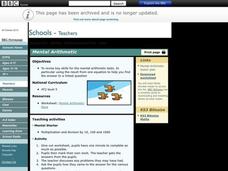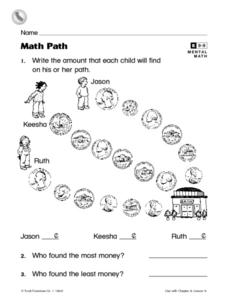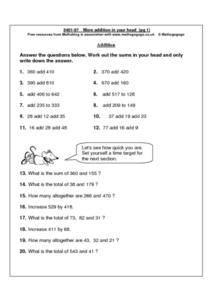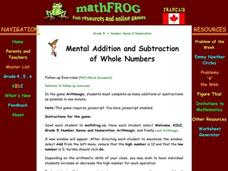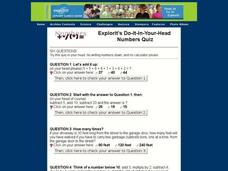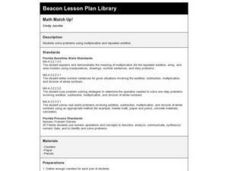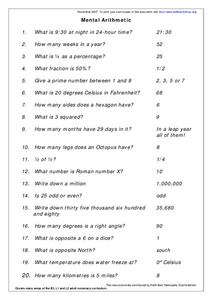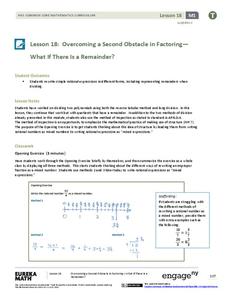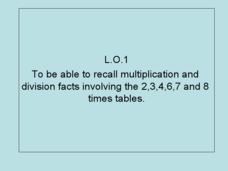Curated OER
Mental Arithmetic
Fifth graders complete a mental arithmetic race worksheet while reviewing the associated concepts. In this mental math lesson, 5th graders complete as much of the associated worksheet as they are able to in one minute. They review and...
Curated OER
Finding a Way
For this mental math worksheet, 3rd graders use mental math to find and solve each missing product, sum and/or difference in each of the 4 paths. Students answer 1 short answer question relating to the paths.
Curated OER
Math Path
In this mental math activity, students practice counting money and comparing amounts. They first count the total amount of money that each of the 3 children will find on their way to the bank, and then they answer 2 questions about the...
Curated OER
What Must Be Added?
In this addition worksheet, students, while answering 15 addition questions, answer each question without doing any written work. Students solve each answer with mental math strategies.
Curated OER
More Addition in Your Head
In this mental math addition worksheet, students determine sums. In this problem solving worksheet, students write answers to twenty problems.
Curated OER
Mental Addition and Subtraction
Students play the online game ArithmAttack to practice mental math skills. They play the game to as many additions or subtractions as possible in sixty seconds. Afterward, they complete a paper based follow up exercise.
Curated OER
Picture Graphs
An innovative way to practice reading data, as well as the four operations! Three picture graphs prompt first graders to count marbles, books, and pets. They also solve addition and subtraction problems. Additionally, they work on...
Curated OER
Factors of Numbers from 1 to 30
Finding factors is an integral skill on the road to fractions and algebra. Scholars write down a factor list for nine numbers up to 30. Next, they examine provided lists and circle the numbers that are factors of eight more numbers, also...
DK Publishing
Finding Multiples 2, 5, and 10
Solidify multiplication facts by identifying multiples of two, five, and 10. There are six sets of numbers here, and for each set learners circle those that are multiples of one of these numbers (two sets for each). Use the example to...
Curated OER
Algebra: Addition and Subtraction Equations: Practice
In this addition and subtraction equations worksheet, students use mental math to solve the addition and subtraction equations. Students then answer two test prep questions.
Curated OER
Explorit's Do-It-In-Your-Head Numbers Quiz
In this mental math worksheet, students complete a 6 question multiple choice online interactive activity without using pencil, paper or calculator. Included are word problems, multiple operations, averaging, and basic arithmetic.
Curated OER
Fun Figures
For this mental math worksheet, students solve 4 problems pertaining to scoring points in a target game. Students compute game scores mentally to answer each story problem.
Curated OER
Math Match Up!
Help learners solve problems using multiplication and repeated addition. Using counters, learners will be paired up to solve problems. They will go through a series of questions and show models with the counters for the solution. Then...
Curated OER
More Addition in Your Head pg 1
Addition using mental math is the focus of this math worksheet. Learners solve two and three-digit number problems, and attempt to do so without the use of pencil and paper. Twenty problems are solved. Answers appear at the end of the...
CCSS Math Activities
Smarter Balanced Sample Items: 8th Grade Math – Target H
Pythagoras is all about being right. A presentation provides sample items for how the Pythagorean Theorem standards may show up in Smarter Balanced assessments. Seven items use the Pythagorean Theorem to find the sides of a right...
Curated OER
Mental Arithmetic
In this math worksheet, students are read a series of questions. They answer them mentally. The questions and answers are on the worksheet.
Curated OER
Altitude of A Rocket
The first two slides set up the conditions for this "experiment on paper". A fun activity where students chose which of the rockets will fly higher in the situations given. Each slide is followed by an answer page and this...
Math 4 Children
Who Wants to be a Champion? - Comparing Numbers
Some excellent practice in mental math, and comparing numbers, awaits your class in this engaging Jeopardy-style game. They can earn bronze, silver, and gold medals by answering questions correctly. The categories include comparing...
Curated OER
Subtraction-There's Got to be An Easier Way!
Third graders observe and demonstrate a variety of problems involving subtraction problems using mental math strategies. They discuss the base ten system and the basic concept of subtraction, and complete a variety of activities...
EngageNY
Polynomial, Rational, and Radical Relationships
This assessment pair goes way beyond simple graphing, factoring and solving polynomial equations, really forcing learners to investigate the math ideas behind the calculations. Short and to-the-point questions build on one another,...
EngageNY
Overcoming a Second Obstacle in Factoring—What If There Is a Remainder?
Looking for an alternative approach to long division? Show your classes how to use factoring in place of long division. Increase their fluency with factoring at the same time!
Curated OER
Recalling Multiplication and Division Facts
A fabulous presentation on multiplication and division facts. In it, learners work in pairs to solve all sorts of problems, puzzles, brain teasers, and mental math problems. These problems focus on multiplication, division, rounding, and...
Curated OER
Using Math with Sale Papers
Fifth graders estimate their results and then prove through calculations. In this math lesson plan, 5th graders solve problems using multiplication, division, addition, and subtraction. They also use mental math to solve their problems.
Achieve
Yogurt Packaging
Food companies understand how to use math to their advantage. Learners explore the math related to the packaging and serving size of yogurt. They then use unit analysis and percent values to make decisions on the product development.
